Do you know where the first Union shots were fired during the Civil War? That's right, Pensacola, Florida. If that's not what you answered, read on.
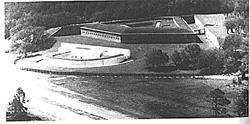 In November, 1860, Abraham Lincoln was elected President without receiving one electoral vote from a Southern state. In December, South Carolina seceded from the Union, taking some of the other Southern states with it. A number of coastal defense installations in Southern states were manned by Federals and tasked with defending key ports and facilities along the entire Gulf of Mexico coastline. One of these facilities was Fort Barrancas, protecting Pensacola Harbor.
In November, 1860, Abraham Lincoln was elected President without receiving one electoral vote from a Southern state. In December, South Carolina seceded from the Union, taking some of the other Southern states with it. A number of coastal defense installations in Southern states were manned by Federals and tasked with defending key ports and facilities along the entire Gulf of Mexico coastline. One of these facilities was Fort Barrancas, protecting Pensacola Harbor.
As events unfolded and war appeared imminent, the outgoing Buchanan administration did nothing to protect or warn the coastal defense garrisons. In January of 1861, the Company commander and second in command of the Field Artillery Company were allowed to take leave. The rapid approach of hostilities forced First Lieutenant Adam J.Slemmer to take command of the Company and make preparations for defense of the fort from a rumored takeover by the Florida State Militia.
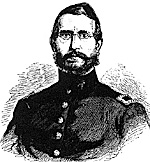 Commodore James Armstrong, Commandant of the Navy Yard conferred with Slemmer and Second Lieutenant Jeremiah H. Gilman on the 5th of January, 1861, deciding it was time to take action. Slemmer moved his men from the barracks to within the walls of Fort Barrancas, established a guard, and raised the drawbridge at night.
Commodore James Armstrong, Commandant of the Navy Yard conferred with Slemmer and Second Lieutenant Jeremiah H. Gilman on the 5th of January, 1861, deciding it was time to take action. Slemmer moved his men from the barracks to within the walls of Fort Barrancas, established a guard, and raised the drawbridge at night.
First Shots
At about midnight on 8 January, a group of unidentified men approached the entrance to Fort Barrancas. Failing to answer the challenge, this group was fired on by the guard. The group retreated into the forest to the northwest. The alarm was raised and Slemmer doubled the guard in anticipation of a greater thrust - which never materialized. The shots fired by the guard at the group of men later identified as lead elements of the Florida State Militia were the first Union shots fired at Confederates during the Civil War. There were no casualties for this brief encounter.
On the 9th and 10th, with the help of the armed steamer Wyandotte and the storeship Supply from the Navy Yard, 1st Lt Slemmer transferred all his men, 31 extra sailors from the Navy Yard, and materiel from Barrancas across the inlet to Fort Pickens on Santa Rosa Island. All the fixed ammunition, most the powder, and other supplies were taken from Barrancas and Fort McRee. As a final point of order, Slemmer's men spiked the cannon remaining at the abandoned forts.
Vacancy
Once Slemmer arrived at Fort Pickens, he learned that much work remained. The fort had not been occupied for ten years. Despite this 40 cannon remained in position.
By 12 January, the Florida State Militia had consolidated under the command of Colonel Tennant Lomax and numbered anywhere from 300 to 800 men. The disparity in numbers is a result of the loose organization of militia at that time. Colonel Lomax approached the Navy Yard with his troops and called for the Union troops to surrender. Commodore Armstrong, having retained only 30 Marines and 30 sailors, faltered in the face of the superior numbers and surrendered his men and installation to Lomax. Not all present were as intimidated. The commander of the Wyandotte took the Supply in tow and sailed his ship into the harbor, wresting both vessels from the Confederates' grasp. Armstrong was later court-martialled for his actions.
Alone
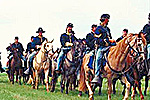 Slemmer and his 81 men stood alone. On the afternoon of the 12th, 3 officers of the Florida State Militia and an employee of the Navy Yard who was familiar with Slemmer and Gilman rowed to Santa Rosa and walked to Fort Pickens. The officers demanded Slemmer's surrender and that Pickens be turned over to the Confederacy. Slemmer refused. The Confederates left and didn't return. There's no doubt that a determined assault on the fort would have been successful, but before this course of action was selected, a U.S. Senator from Florida, Stephen R. Mallory and President Buchanan negotiated a truce stipulating that Fort Pickens would not be attacked as long as it was not reinforced.
Slemmer and his 81 men stood alone. On the afternoon of the 12th, 3 officers of the Florida State Militia and an employee of the Navy Yard who was familiar with Slemmer and Gilman rowed to Santa Rosa and walked to Fort Pickens. The officers demanded Slemmer's surrender and that Pickens be turned over to the Confederacy. Slemmer refused. The Confederates left and didn't return. There's no doubt that a determined assault on the fort would have been successful, but before this course of action was selected, a U.S. Senator from Florida, Stephen R. Mallory and President Buchanan negotiated a truce stipulating that Fort Pickens would not be attacked as long as it was not reinforced.
And so goes the history of the first Union shots of the Civil War. Fort Pickens was held by the Union for the duration of the war. Later history included cannon battles between Pickens, Barrancas, McRee, and two Union frigates. In the 1880's, Geronimo, his chiefs, wives, and children were imprisoned at Fort Pickens. In all, these Coastal Defenses were never tested by an attack from the sea, but provided the passive deterrence that is the symbol of superior firepower.
Scenario
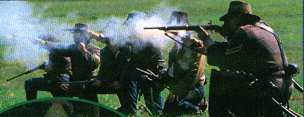 If you want to play a "what if" scenario with 300 Florida State Militia assaulting Slemmer and his 50 artillerymen in Fort Barrancas, the following notes are offered.
If you want to play a "what if" scenario with 300 Florida State Militia assaulting Slemmer and his 50 artillerymen in Fort Barrancas, the following notes are offered.
- - use skirmish rules with no more than a 1:3 figure to men representation
- all Union soldiers are average riflemen with muzzleloaders (.54 cal)
- all Confederate soldiers are above-average riflemen with muzzleloaders (.577 cal)
- at midnight on the 8th, only Slemmer and approx 20 men are awake. It will take 1d6+4 turns to sound the alarm, awaken the troops, and have them ready to fight. The first attempt by the Confederates must be the drawbridge.
- The ingress/egress points for Fort Barrancas are the drawbridge, adjacent door, 4 cannon ports (covering the dry moat), underground passage to the water battery, and the parade ground door.
- The firing slits are only six inches wide with extremely limited visibility (especially after a rifle has been fired out of one)
- Less than a full moon provides poor visibility for both forces
- Morale is above average for both forces.
- 12 pdr cannons are loaded with grapeshot at each of the four cannon firing ports. These cannon require a minimum of 5 men each to load and fire.
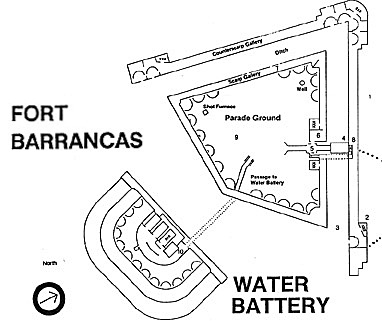
Back to Rebel Yell No. 5 Table of Contents
Back to Rebel Yell List of Issues
Back to Master Magazine List
© Copyright 1997 by HMGS South
This article appears in MagWeb (Magazine Web) on the Internet World Wide Web.
Other military history articles and gaming articles are available at http://www.magweb.com